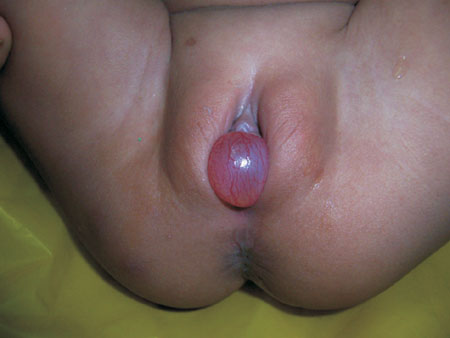A 10 months old female child was brought with the complaints of a mass
coming out through her urethra ( Fig. 1) when the child
passed urine since last two months. The child was not able to pass urine
whenever the mass prolapsed. There was no history of fever, hematuria,
chronic cough or constipation. A diagnosis of cecoureterocele was made
based on the presence of cystic mass at the external urethral meatus and
urinary retention. Ultrasound showed a cystic mass at the end of ureter
with or without hydronephrosis and voiding cystourethrogram demonstrated
smooth round filling defect.
 |
|
Fig. 1 Cecoureterocele. |
An ureterocele is a congenital saccular dilatation of
the terminal portion of the ureter. Cecoureterocele is an uncommon type
where the ureterocele is elongated beyond its orifice by tunneling under
the trigone and the urethra .
Common complications include urinary tract infection,
symptoms of obstructive voiding, urinary retention, failure to thrive and
abdominal pain. Untreated, these may lead to hydronephrosis or
pyonephrosis, A cecoureterocele presenting as a prolapsing mass at
urethral meatus should be differentiated from urethral prolapse presenting
with bleeding, spotting, dysuria, urinary frequency, introital pain, and
urinary incontinence or retention; and sarcoma botryoides which presents
as a firm grapelike vaginal mass protruding through the introitus with
occasional bleeding.

